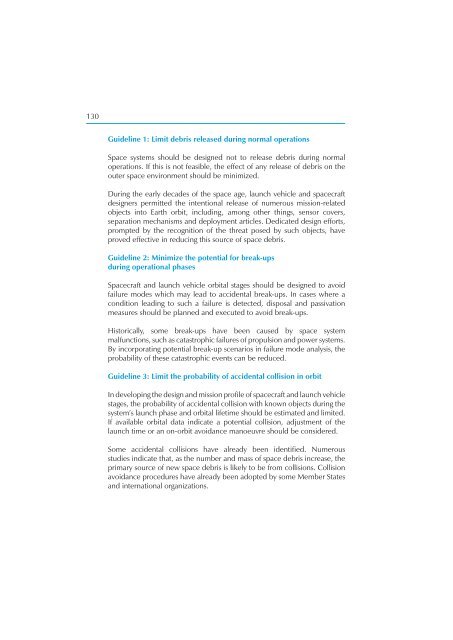Security in Space The Next Generation - UNIDIR
Security in Space The Next Generation - UNIDIR
Security in Space The Next Generation - UNIDIR
You also want an ePaper? Increase the reach of your titles
YUMPU automatically turns print PDFs into web optimized ePapers that Google loves.
130<br />
Guidel<strong>in</strong>e 1: Limit debris released dur<strong>in</strong>g normal operations<br />
<strong>Space</strong> systems should be designed not to release debris dur<strong>in</strong>g normal<br />
operations. If this is not feasible, the effect of any release of debris on the<br />
outer space environment should be m<strong>in</strong>imized.<br />
Dur<strong>in</strong>g the early decades of the space age, launch vehicle and spacecraft<br />
designers permitted the <strong>in</strong>tentional release of numerous mission-related<br />
objects <strong>in</strong>to Earth orbit, <strong>in</strong>clud<strong>in</strong>g, among other th<strong>in</strong>gs, sensor covers,<br />
separation mechanisms and deployment articles. Dedicated design efforts,<br />
prompted by the recognition of the threat posed by such objects, have<br />
proved effective <strong>in</strong> reduc<strong>in</strong>g this source of space debris.<br />
Guidel<strong>in</strong>e 2: M<strong>in</strong>imize the potential for break-ups<br />
dur<strong>in</strong>g operational phases<br />
<strong>Space</strong>craft and launch vehicle orbital stages should be designed to avoid<br />
failure modes which may lead to accidental break-ups. In cases where a<br />
condition lead<strong>in</strong>g to such a failure is detected, disposal and passivation<br />
measures should be planned and executed to avoid break-ups.<br />
Historically, some break-ups have been caused by space system<br />
malfunctions, such as catastrophic failures of propulsion and power systems.<br />
By <strong>in</strong>corporat<strong>in</strong>g potential break-up scenarios <strong>in</strong> failure mode analysis, the<br />
probability of these catastrophic events can be reduced.<br />
Guidel<strong>in</strong>e 3: Limit the probability of accidental collision <strong>in</strong> orbit<br />
In develop<strong>in</strong>g the design and mission profi le of spacecraft and launch vehicle<br />
stages, the probability of accidental collision with known objects dur<strong>in</strong>g the<br />
system’s launch phase and orbital lifetime should be estimated and limited.<br />
If available orbital data <strong>in</strong>dicate a potential collision, adjustment of the<br />
launch time or an on-orbit avoidance manoeuvre should be considered.<br />
Some accidental collisions have already been identifi ed. Numerous<br />
studies <strong>in</strong>dicate that, as the number and mass of space debris <strong>in</strong>crease, the<br />
primary source of new space debris is likely to be from collisions. Collision<br />
avoidance procedures have already been adopted by some Member States<br />
and <strong>in</strong>ternational organizations.








